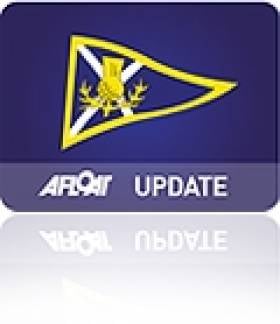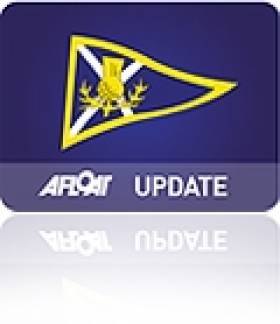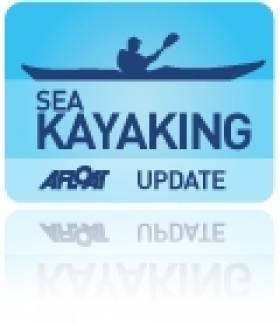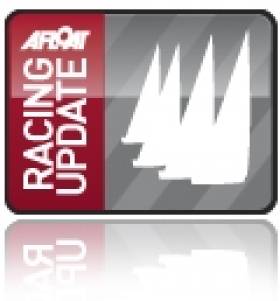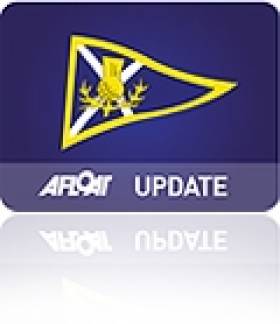Displaying items by tag: Scotland
Scotland's Class of Champions
#Scottishseries – Tarbert's local sailing hero Ruairidh Scott, who in 2003 won the prestigious Scottish Series Trophy overall returns to his native waters later this week when he competes again in the Brewin Dolphin Scottish Series Regatta.
Now based near Southampton, sail-maker and pro sailor Scott will race in IRC Class 3 as tactician on Grant Gordon's successful south of England based J97 Fever Glenfiddich. While Scott may have aspirations of lifting the premier event's top award for the second time, he and the Fever crew will find themselves up against a tough cross section of past Scottish Series champions, not least the 2011 winning boat, the J97 Jackaroo of Jim and Steve Dick.
In fact there are three J97's competing in the class, top Clyde helm Iain Laidlaw, assisted by sail-maker Chris Owen, finished a close second to the Fever crew at the Savills Kip Regatta, the warm up event a couple of weeks ago.
Though the J97's took 1,2,3 at Kip they might not have it their own way on Loch Fyne – where racing starts Friday and finishes Monday afternoon – as Cork's Anthony O'Leary, the skipper who won the Trophy in 2004 and 2006, will renew a friendly rivalry with Scott which goes back more a dozen years. O'Leary races his modified 1720 Sportsboat under IRC handicap with a crack Cork crew.
Also in the mix in this virtual champion-of-champions class is Howard Morrison, past commodore of Clyde Cruising Club, organisers of the Scottish Series. It will be 21 years ago this year since Morrison won the Scottish Series Trophy on Ufor, his UFO31, but he has been a regular podium finisher ever since.
Grant Gordon is a passionate Scottish owner who has had and raced a number of yachts called Fever which he has campaigned from their Solent base. He chooses key regattas each year out with English waters and this year he returns to Tarbert, to one of his personal favourites.
"We have won the national championships and were second at Cowes with the boat and we feel we are pretty competitive, though we know the other J97's have been well sailed. It is always a pleasure to be back at Tarbert and one place I look forwards to each year." Comments Scott.
If there is something of a homecoming theme for the Fever owner and the tactician, that extends through the crew which, despite being mainly English bases, is 75% born and bred Scots.
Current champion Jim Dick will unfortunately not be able to compete on board his 2011 trophy winning boat due to an arm injury, and his winning skipper-helm Hamish Mackay has commitments elsewhere. But J/Boats' Peter Cameron and Dave Kelly who won with Dick and crew, will form the backbone of the Jackaroo team this year.
Scottish Series Social Programme Confirmed
#SCOTTISH SERIES – Clyde Cruising Club, organisers of the Brewin Dolphin Scottish Series, today confirmed the much anticipated social programme for this year's event, which will create a festival of sailing for competitors and spectators alike.
Taking place during the Queen's Jubilee weekend from Friday 1 June to Monday 4 June in Tarbert, Loch Fyne, a fun and entertaining social programme is being added to the quality racing of the event.
A fantastic new marquee complex on the north shore of Tarbert, where the yachts will be berthed will become the social hub for the entire weekend. Those with fond memories of the marquee experience from previous years will not be disappointed with the new look and feel for this year's event, which promises a whole host of entertainment.
Competitors can meet, relax and socialise post racing in the dedicated marquee bar* which will also be the heart of a daily prize-giving ceremony, capturing the spirit of the Brewin Dolphin Scottish Series. Those attending on Saturday will be able to enjoy an exclusive whisky tasting session, courtesy of new event sponsors Bowmore, Islay Single Malt Whisky, and will be entertained with live music throughout the weekend.
In addition to the marquee, participants and spectators can soak up the atmosphere and enjoy local musicians, pipe bands, a Tea Party, a family ceilidh, a fireworks display and Water Waltzers. There are also separate events for kids.
John Watson, Commodore of Clyde Cruising Club, said: "We are very excited about this year's Brewin Dolphin Scottish Series and delighted that the marquee is back for 2012.
"As the social hub for the weekend the marquee will help create a vibrant, enjoyable and truly unique experience for all participants who help make it a spectacular sailing event every year. With our added fun shoreside entertainment we hope this will be the best Scottish Series to date.
"We would encourage more sailors from across the UK and further afield to consider entering the event and past competitors to continue to return to the stunning waters of Loch Fyne to soak up the wonderful atmosphere Tarbert has to offer."
UK Laser Sailors in £50K Irish Sea Crossing Challenge
#LASER - A pair of British sailors are set to embark on an intrepid crossing of the Irish Sea using just two single-handed Laser dingies.
David Summerville and Steve Cockerill had originally planned to make the crossing in September last year, but those plans were scuppered by 50-knot gale force winds and a 12-foot tidal swell, according to Incentive Travel.
But the duo is now planning to try again, with the backing of the Ramada Plaza Southport.
“David and Steve will be covering 115 nautical miles during the challenge," said Ramada Plaza general manager Enda Rylands. "They will set off from my own home town of Dublin and finish in Southport, aiming to raise £50,000 for mental health charity Mind and the John Merricks Sailing Trust."
Summerville, a 53-year-old grandfather of two who runs a boat repair business, said the date of the challenge would again depend on weather and tidal conditions, and that the pair is ready to depart any time from mid-April to mid-September.
It's not the first time that an Irish Sea crossing has been done in a Laser as Tiffany Brien achieved the feat in 2010, sailing single-handedly the 30 miles from Portpatrick in Scotland to Belfast Lough.
But Summerville and Cockerill's ambitious undertaking, at more than three times that distance, would surely get them a place in the record books - provided the weather goes their way!
Duo Set for Sea Kayaking Challenge off Western Scotland
#SEA KAYAKING - Brit duo Andy Pearson and Paul A'bear will embark on a 500-mile sea kayaking voyage along Scotland's west coast this summer in aid of charity.
Canoe & Kayak UK reports that the pair will set out from the Solway Firth near the Scottish border at the end of June on the expedition that will take them through the Irish Sea to the Atlantic Ocean.
The adventure will see them paddle through "wild, stormy seas" and "some of the strongest tidal currents in the world".
Pearson and A'bear, who have been friends since primary school, hope to raise at least £1,000 for Cancer Research UK.
For more details on their adventure visit www.westcoastchallenge2012.co.uk.
Ailsa Craig Race Celebrates 50th Anniversary
#RACING UPDATE - This summer the Royal Ulster Yacht Club will stage the 50th anniversary edition of the Ailsa Craig Race, one of the classics of the Northern Ireland offshore yacht racing calendar.
Many of the competitors from the inaugural race in 1962 - several of whom are now in their 80s - are expected to compete in the overnight challenge, which takes the fleet from Bangor to the rock at the mouth of the Clyde in Scotland.
The 2012 Ailsa Craig Race, sponsored by Hamilton Shipping, takes place on 15 June.
Al Mennie's Epic Charity Paddle from Giant's Causeway
#SURFING - Northern Irish surf pro Al Mennie will be taking on a different challenge later this month, when he sets out to paddle a surfboard from the Giant's Causeway to Scotland in the name of charity.
"It will be the northernmost crossing of its type in the world," says Mennie of the 25-mile route from Antrim to the Scottish island of Islay.
"I will have to deal with freezing cold temperatures, large open ocean swell, potentially high winds and the deadly currents around a well known navigational hazard of a North Atlantic island."
Mennie will be on his own except for a support boat carrying food and water. He will be wearing a 6mm wetsuit and crossing the most dangerous stretch of water around the Irish coastline, "known for its extremely deadly currents as the Irish Sea tides drain between Rathlin Island and Northern Ireland".
The NI surfer is embarking on the challenge in aid of Northern Ireland Chest Heart and Stroke, which is a charity close to his own heart.
"My dad died suddenly of a heart attack aged 50 and I know lots of people who have also lost loved ones to heart problems too," he says, "so I really want to help make a difference by raising money for this charity."
For more details or to make a donation, visit the charity page at Al Mennie's website HERE.
Tarbert Welcomes Defending Champion for Scottish Series
#SCOTTISH SERIES – No sooner had Brewin Dolphin Scottish Sailing Series winner Jim Dick received the Scottish Series Trophy, the prestigious top award, than the Humberside owner-skipper pledged to return to Tarbert, Loch Fyne in 2012 to try and defend the title again.
Dick, a retired business executive, is set to honour that promise and is presently putting together his campaign which he hopes will see Jackaroo retain the major trophy.
"We have such good memories from last year aside from the enjoyment of winning outright. For us it was as much about enjoying the surroundings, the camaraderie of the team and at the event, and Tarbert itself," recalls Dick.
The J/97 owner is hoping that this year his son Steve, who is a paramedic, will be able to join the Jackaroo team and enjoy the Brewin Dolphin Scottish Series for the first time, during the Queen's Jubilee Bank Holiday weekend.
The 2012 Brewin Dolphin Scottish Series will be the first of a series of events in the UK for Jackaroo which is likely to include the J/Cup on the Solent in July, the J/97 National Championships and the JP Morgan Round the Island Race.
His passion for sailing took Jim Dick to compete as a crew member on 'Hull and Humber' in the 2007-8 Clipper Round the World Race.
Completely inspired by the transformation that participation in the race made to the lives of some of the Hull and Humber's young crew, who were part of a social inclusion programme, helping them develop skills and self confidence which subsequently helped them find employment or advance into education or further training, Dick became co-founder of CatZero, an organisation which has subsequently helped hundreds of young people find a purpose in their lives.
"When I saw the transformation in the ten young people on board, much higher self esteem, very enthusiastic about what they were doing and how they became valued members of the crew, that progressed to setting up CatZero."
Funding from the NHS enabled the purchase for CatZero of a 72 foot Challenge yacht which is used to take youngsters on 10-day passages from Hull to the Orkney Islands.
"Of course this is a big challenge to some of these young people, standing four hour watches, dealing with sea sickness, the conditions can be extreme, but the results are incredible. Over three years we have had 418 young people, some who have been very difficult or in very difficult life situations, on board and 285 have gone on to jobs, education or training. A lot have had underlying problems, being bullied, homelessness or the like, but the results are remarkable."
In order to help raise funds towards the annual budget of £250,000 which it costs to keep the programme rolling, CatZero sells berths aboard the 72 footer for major races such as the ARC Race in which they won their class and the Fastnet Race.
The Brewin Dolphin Scottish Series 2012 will take place over the Queen's Jubilee weekend from Friday 1 June to Monday 4 June in Tarbert, Loch Fyne, on Scotland's stunning West Coast, a week later than usual.
Two Bodies Recovered from Water Near Belfast
#NEWS UPDATE - The PSNI has confirmed that the body recovered from Belfast Lough yesterday morning is that of missing Stranraer man Carius McNicoll.
According to BBC News, the 24-year-old student was last seen on a ferry shortly before docking on 8 January.
His body was discovered near Holywood in Co Down. A post-mortem has confirmed that the cause of death was drowning.
In a separate incident yeserday, The Irish Times reports that a body recovered by divers in the River Lagan is believed to be that of a missing 20-year-old man.
John Murphy had reportedly entered the river at the Lagan Weir after an evening at the nearby Odyssey Arena last month. The body found has yet to be formally identified as Murphy.
In the wake of his loss, Murphy's family has called for an end to cheap drinks promotions.
Scottish Search and Rescue Base UK's Busiest in 2011
#RESCUE - The Royal Navy search and rescue unit at HMS Gannet was the busiest in the UK last year, STV News reports.
The unit - based in Prestwick, near Glasgow - responded to nearly 300 call-outs and rescued 240 people in Scotland, northern England and Northern Ireland throughout 2011 with its fleet of Sea King helicopters.
The big numbers put HMS Gannet at the top of the UK's 12 search and rescue units for the fifth year running.
"Like all emergency services, we work under significant pressure and always aim to provide the best service we possibly can," said HMS Gannet's Lieutenant Commander Debdash Bhattacharya. "Frequently lives depend on it."
Since 2007 the unit has rescued 1,575 people from 1,865 call-outs in total. Last year's call-outs represented 17% of all call-outs from military bases in the UK.
STV News has much more on the story HERE.
IWDG Secures 75% Funding for Celtic Mist Refit
#TALL SHIPS - The Irish Whale and Dolphin Group (IWDG) has secured three-quarters of the funding it required to refit its research vessel Celtic Mist.
According to The Irish Times, the Clare Local Development Company has approved the allocation of a €48,000 grant towards the refurbishment of the ketch.
The work will be carried out by Cathal Blunnie and several sub-contractors, and involves stripping down the main cabin and removing the bath and shower to increase space for crew berths.
While the ship's clock will be retained, the ship’s wheel in the main cabin will be removed and presented to the Haughey family as a gesture of appreciation.
As previously reported on Afloat.ie, the 52-foot yacht - which was gifted by the Haughey family to the IWDG to assist in its marine wildlife conservation work - entered dry dock last November in preparation for the refit work, after relocating to its new berth at Kilrush, Co Clare in July.
This followed its last jaunt at sea in its former guise, completing a leg of the Tall Ships Races from Waterford to Greenock in Scotland.
The cost of refurbishing the yacht for research and training purposes is expected to top €60,000, with an annual running cost of some €20,000, for which the IWDG is seeking ongoing financial assistance.
The group aims to get the Celtic Mist back at sea before the summer.





























